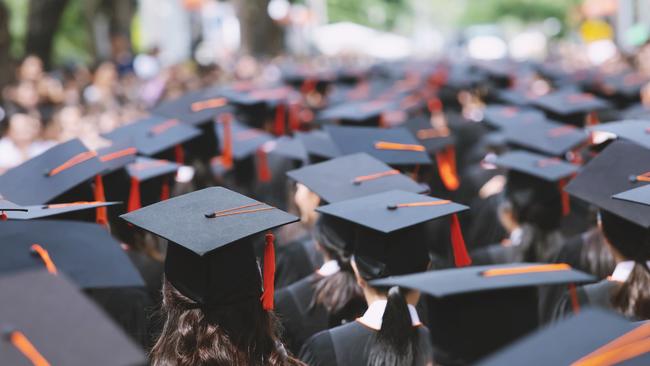Student debt soars to $81bn as tuition fees increase for university degrees
University degrees will cost more next year as 2025 tuition fee hikes are revealed, with student debts hitting a record high.

University graduates owe taxpayers a record $81bn in student loans, as debts snowball with inflation and degrees grow more expensive.
Graduates are taking longer to pay back their HELP/HECS debts, with indexation adding $3.4bn to the outstanding loan bill last financial year, new Australian Taxation Office data shows.
The cost of university degrees will rise 4 per cent next year, when students will be charged $16,992 for one year of study in law, accounting, business, communications or arts degrees.
The federal government will pay a $1286 “gap fee’’ for these degrees, bringing the total cost to $18,278 a year.
The cheapest degrees – teaching, nursing, mathematics or statistics – will increase to $4627 for a year of study in 2025, with taxpayers chipping in $15,526.
A degree in allied health, computing, performing arts and social work will cost students $9314 for next year’s study, with taxpayers contributing $15,526.
As senators debate the Albanese government’s Student Support bill to change the indexation method, the ATO has revealed a 140 per cent jump in outstanding debts over the past decade.
Graduates don’t have to pay back their government-funded student loans until they earn $54,435 per year, meaning they can avoid repayments if they earn a low wage, work part-time, are unemployed or caring for children, or retire.
The ATO data shows the federal government has already written off $241m, mainly due to 23,247 graduates dying in debt.
It is likely to write off another $2.2bn in outstanding debts owed by 133,000 baby boomers older than 60, who are unlikely to pay back the money once they retire.
The number of graduates owing more than $100,000 has doubled in the past three years, from 27,238 in 2020-21 to 56,974 last financial year.
And 1261 graduates owe more than $200,000 – including four with debts of more than $400,000.
The ATO data shows that graduates are now taking nearly 10 years to pay back their debts, compared with just over seven years in 2004-05.

University students are able to borrow their tuition fees from the federal government through its Higher Education Loans Program, previously known as the Higher Education Contribution Scheme.
The cost has ballooned from $33.8bn in 2013-14, with an average debt of $16,933 per student, to $81bn in 2023-24, when the average debt had soared to $27,643.
The number of graduates jumped from 2 million a decade ago to 2.9 million last year.
But the value of unpaid debts has risen 18 per cent in the past three years, despite no increase in the number of graduates.
Student loans are technically “interest-free” and paid back gradually as an extra tax levy, based on a student’s income.
The outstanding amount is indexed every year in line with inflation, resulting in a 7 per cent increase last year that added more debt to some graduates’ bills than they managed to repay.
The debts are a hurdle for homebuyers because most banks take HELP/HECS debts into account in loan applications.
The Albanese government’s bill to change indexation rates to the lower of the consumer price index or wage price index has stalled in the Senate.
The federal Education Department told the Senate education committee’s hearing into the Student Support bill in Sydney on Tuesday that some graduates will never repay their debts.
“The income-contingent nature of HELP supports access to higher education and means that people on consistently low incomes may never be required to make a repayment,’’ its submission states.
“The HELP system has enabled growth of the higher education system in an affordable way.
“This includes increasing participation rates among students from low socio-economic backgrounds.’’
The department said indexation charges must be added to “ensure debts retain their real value over time’’.
“If debts were not indexed, any drop in real value would have significant financial implications for the government of the day,’’ it says.
“The proposed amendment will cap the indexation of HELP and other income-contingent loans to the lower of CPI or WPI to ensure they never grow faster than wages in the future.’’
The proposed bill will let the ATO backdate its indexation calculation from 7.1 per cent to 3.2 per cent, and adjust this year’s indexation from 4.7 per cent to 4 per cent.
“This will reduce the amount of debt people would have paid in 2023, and will pay in 2024,’’ the submission says.
Departmental assistant secretary Larissa Hinds told the hearing the changes will cut $3bn from outstanding HELP debts.
In addition to bankrolling $81bn in student loans, taxpayers also spend $7.5bn a year in direct subsidies for university degrees through commonwealth-supported places.







To join the conversation, please log in. Don't have an account? Register
Join the conversation, you are commenting as Logout